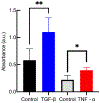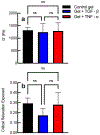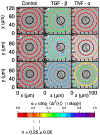A Rheological Study on the Effect of Tethering Pro- and Anti-Inflammatory Cytokines into Hydrogels on Human Mesenchymal Stem Cell Migration, Degradation, and Morphology
- PMID: 38961715
- PMCID: PMC11956429
- DOI: 10.1021/acs.biomac.4c00508
A Rheological Study on the Effect of Tethering Pro- and Anti-Inflammatory Cytokines into Hydrogels on Human Mesenchymal Stem Cell Migration, Degradation, and Morphology
Abstract
Polymer-peptide hydrogels are being designed as implantable materials that deliver human mesenchymal stem cells (hMSCs) to treat wounds. Most wounds can progress through the healing process without intervention. During the normal healing process, cytokines are released from the wound to create a concentration gradient, which causes directed cell migration from the native niche to the wound site. Our work takes inspiration from this process and uniformly tethers cytokines into the scaffold to measure changes in cell-mediated degradation and motility. This is the first step in designing cytokine concentration gradients into the material to direct cell migration. We measure changes in rheological properties, encapsulated cell-mediated pericellular degradation and migration in a hydrogel scaffold with covalently tethered cytokines, either tumor necrosis factor-α (TNF-α) or transforming growth factor-β (TGF-β). TNF-α is expressed in early stages of wound healing causing an inflammatory response. TGF-β is released in later stages of wound healing causing an anti-inflammatory response in the surrounding tissue. Both cytokines cause directed cell migration. We measure no statistically significant difference in modulus or the critical relaxation exponent when tethering either cytokine in the polymeric network without encapsulated hMSCs. This indicates that the scaffold structure and rheology is unchanged by the addition of tethered cytokines. Increases in hMSC motility, morphology and cell-mediated degradation are measured using a combination of multiple particle tracking microrheology (MPT) and live-cell imaging in hydrogels with tethered cytokines. We measure that tethering TNF-α into the hydrogel increases cellular remodeling on earlier days postencapsulation and tethering TGF-β into the scaffold increases cellular remodeling on later days. We measure tethering either TGF-β or TNF-α enhances cell stretching and, subsequently, migration. This work provides rheological characterization that can be used to design new materials that present chemical cues in the pericellular region to direct cell migration.
Conflict of interest statement
The authors declare no competing financial interest.
Figures









Similar articles
-
Systemic pharmacological treatments for chronic plaque psoriasis: a network meta-analysis.Cochrane Database Syst Rev. 2021 Apr 19;4(4):CD011535. doi: 10.1002/14651858.CD011535.pub4. Cochrane Database Syst Rev. 2021. Update in: Cochrane Database Syst Rev. 2022 May 23;5:CD011535. doi: 10.1002/14651858.CD011535.pub5. PMID: 33871055 Free PMC article. Updated.
-
Measuring the Effects of Cytokines on the Modification of Pericellular Rheology by Human Mesenchymal Stem Cells.ACS Biomater Sci Eng. 2021 Dec 13;7(12):5762-5774. doi: 10.1021/acsbiomaterials.1c00871. Epub 2021 Nov 9. ACS Biomater Sci Eng. 2021. PMID: 34752080 Free PMC article.
-
Systemic pharmacological treatments for chronic plaque psoriasis: a network meta-analysis.Cochrane Database Syst Rev. 2020 Jan 9;1(1):CD011535. doi: 10.1002/14651858.CD011535.pub3. Cochrane Database Syst Rev. 2020. Update in: Cochrane Database Syst Rev. 2021 Apr 19;4:CD011535. doi: 10.1002/14651858.CD011535.pub4. PMID: 31917873 Free PMC article. Updated.
-
A rapid and systematic review of the clinical effectiveness and cost-effectiveness of debriding agents in treating surgical wounds healing by secondary intention.Health Technol Assess. 2001;5(14):1-131. doi: 10.3310/hta5140. Health Technol Assess. 2001. PMID: 11399237
-
Systemic pharmacological treatments for chronic plaque psoriasis: a network meta-analysis.Cochrane Database Syst Rev. 2017 Dec 22;12(12):CD011535. doi: 10.1002/14651858.CD011535.pub2. Cochrane Database Syst Rev. 2017. Update in: Cochrane Database Syst Rev. 2020 Jan 9;1:CD011535. doi: 10.1002/14651858.CD011535.pub3. PMID: 29271481 Free PMC article. Updated.
References
-
- Lee PY; Cobain E; Huard J; Huang L Thermosensitive hydrogel PEG–PLGA–PEG enhances engraftment of muscle-derived stem cells and promotes healing in diabetic wound. Mol. Ther 2007, 15, 1189–1194. - PubMed
Publication types
MeSH terms
Substances
Grants and funding
LinkOut - more resources
Full Text Sources

